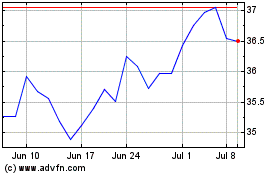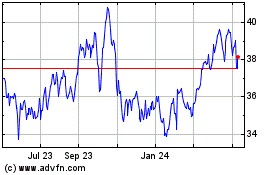By Bradley Olson And Erin Ailworth
The ingenuity and easy money that allowed American oil companies
to keep pumping through a year-long price crash appear to be
petering out as U.S. crude slides toward $40 a barrel.
U.S. companies have stunned global rivals by continuing to
produce oil--particularly from shale deposits--ever more cheaply as
American crude prices plunged from over $100 a barrel in 2014. But
the recent drop toward $40 a barrel and below puts even the most
efficient operators in a bind.
"Forty-dollar to fifty-dollar oil prices don't work in this
business," Ryan Lance, chief executive of ConocoPhillips, the
largest independent U.S. oil producer, said in an interview.
The worst-case scenario most major producers have discussed in
the past six weeks with investors involved a price of $50 a barrel.
That is beginning to look optimistic as Saudi Arabia continues to
produce near-record volumes and major exporters such as Iraq have
increased output. Many oil executives, including BP PLC CEO Bob
Dudley, expect prices to be "lower for longer." The U.S. Energy
Department is forecasting the price of oil will average around $50
a barrel next year.
More than 250,000 people world-wide have lost their jobs in the
industry over the past year, according to Graves & Co., a
Houston consulting firm. Many companies that were hoping to weather
low energy prices without new rounds of layoffs and salary cuts may
be forced to slash those costs yet again, said Eric Lee, an energy
analyst with Citigroup.
"Who's going to take the brunt of this? Shale has already cut
back a lot, " Mr. Lee said, adding that new oil projects are being
deferred around the world.
In a way, he added, oil companies are responsible for the
current situation. During brief price rallies, they raced back into
fields to drill new wells--adding to the global glut of crude and
cutting off the price rebounds. Even as the number of rigs
operating in the U.S. fell 60% so far this year, American oil
production through August dipped just 3% from its April peak,
federal data show.
What happened was a combination of declining costs for oil-field
services and equipment and impressive feats of engineering.
Companies doubled the amount of sand they pumped into wells,
figuring out how to better prop open rock layers to draw out more
oil and natural gas. Operators moved rigs into areas where crude
flowed the most freely, cut the number of days it took to drill by
nearly half and extended the length of horizontal oil wells to
reach nearly 2 miles.
Costs for such big wells fell by as much as a third as oil
explorers put extreme pressure on the suppliers that help them coax
more fuel from the ground, including Halliburton Co. And producers
became far more efficient. In the seven most prolific U.S. shale
fields, they boosted oil production per rig by as much as 60% this
year, according to federal estimates.
That increased efficiency appeared to dramatically improve the
outlook for profits even after crude prices plunged from their June
2014 high. But those gains now appear to be tapering off, according
to oil analysts. U.S. oil production is expected to fall by more
than 5% to 8.8 million barrels a day in 2016, down from an average
of 9.3 million barrels a day this year, according to projections
from the Energy Department.
The boom in shale-oil production came amid wide open capital
markets. As companies ramped up drilling from Texas to North Dakota
in recent years, they frequently paid for new wells either with
cheap debt or new equity. Investors rewarded production growth,
allowing operators to continue drilling even while making little
money.
To the surprise of many analysts, that remained true in the
first half of this year despite the oil-price crash, as companies
issued $11 billion in new equity, according to Dealogic. Since July
that has slowed to a trickle of about $2.6 billion, with only a
handful of companies trying to tap markets for funding in recent
months. Noble Energy Inc.'s effort to spin off some of its pipeline
and gas-processing assets was scuttled this week.
Companies are also hitting a wall in terms of cost cuts.
"We're really reaching the limit of what people can do," said
Allen Gilmer, chief executive of DrillingInfo, an Austin, Texas
company that compiles data on tens of thousands of shale wells
across North America. "Right now, you are down to the best areas,
the best rigs, the best people. Any cuts from now on are bone
rather than fat."
For the past year, energy companies have touted the
profitability of their best prospects, explaining their success to
investors using the concept of a "break-even" cost, generally
defined as the oil price needed to reach a 10%-to-20% profit
margin. When oil was trading around $65 a barrel, many top energy
executives said they could turn a profit even if the price fell to
$60. As costs in the oil fields dropped, those break-even figures
fell along with them, making certain wells profitable even at lower
prices.
Earlier this month, EOG Resources Inc., a Houston-based shale
driller, said some of its most prolific wells would yield a rate of
return above 40%, even with U.S. oil prices at $50 a barrel.
But break-even prices don't always give the whole picture of how
much money a shale company must spend to pump oil and move it to
market. They can exclude land costs, which for some companies
amount to billions of dollars, and they don't include the cost of
using pipelines to transport crude, according to company financial
statements and analyst reports.
In nearly all of its investor presentations this year, EOG has
said it can turn a profit at prices at or below the prevailing oil
price at the time of the presentation. Yet more than $6 billion in
capital spending this year has produced nearly $4 billion in net
losses over the past year for the company, which is an industry
bellwether.
The company, which has said $40 oil is unsustainable, didn't
respond to requests for comment.
EOG isn't alone. In the past 12 months, the 24 largest shale
companies have reported losses totaling more than $62 billion and
many show negative returns.
Energy companies will be forced to cull billions more dollars
from their budgets next year as low crude prices halt drilling
around the world, said Dennis Cassidy, the Dallas-based managing
director of oil and gas at AlixPartners, an advisory focused on
turnarounds. Shale producers with high debt or marginal oil fields
will suffer the most, he said, but added, "Everyone is going to
feel pain at $40."
Write to Erin Ailworth at Erin.Ailworth@wsj.com
Access Investor Kit for "BP plc"
Visit
http://www.companyspotlight.com/partner?cp_code=P479&isin=GB0007980591
Access Investor Kit for "BP plc"
Visit
http://www.companyspotlight.com/partner?cp_code=P479&isin=US0556221044
Subscribe to WSJ: http://online.wsj.com?mod=djnwires
(END) Dow Jones Newswires
November 20, 2015 19:57 ET (00:57 GMT)
Copyright (c) 2015 Dow Jones & Company, Inc.
BP (NYSE:BP)
Historical Stock Chart
From Mar 2024 to Apr 2024

BP (NYSE:BP)
Historical Stock Chart
From Apr 2023 to Apr 2024
